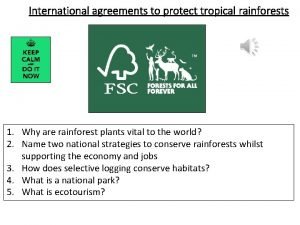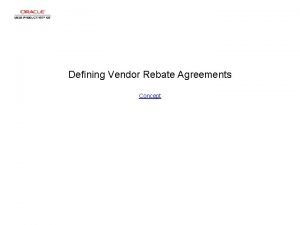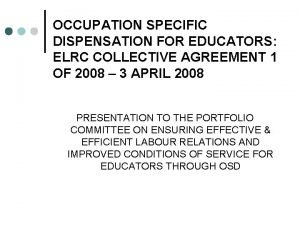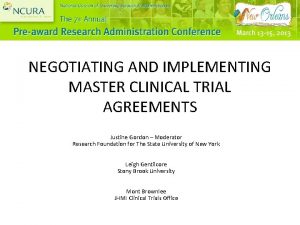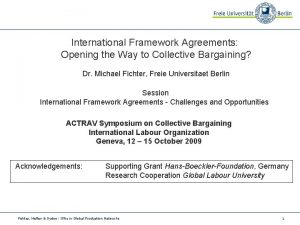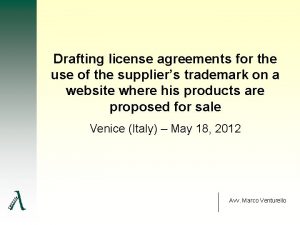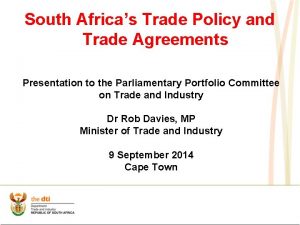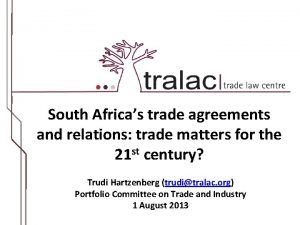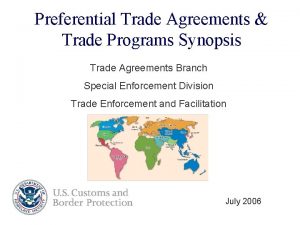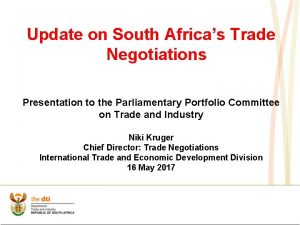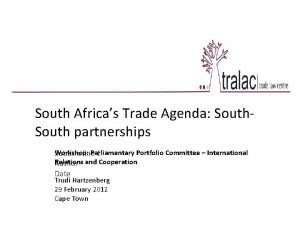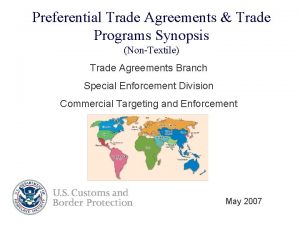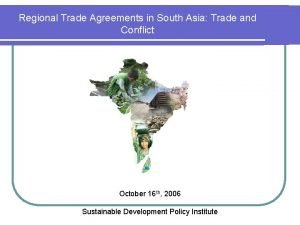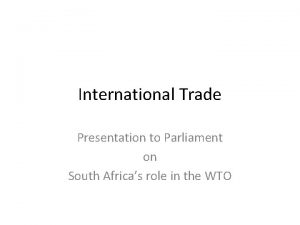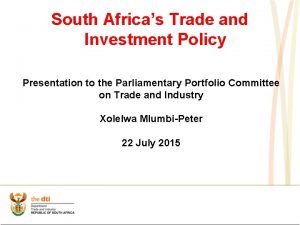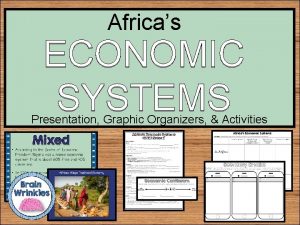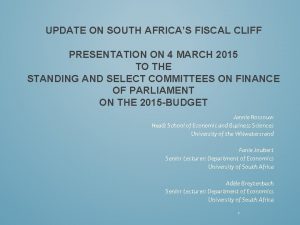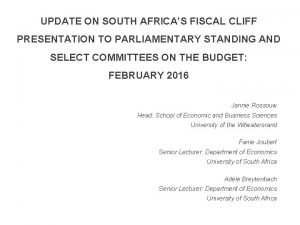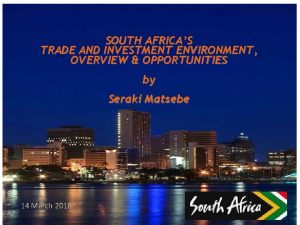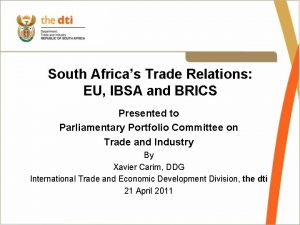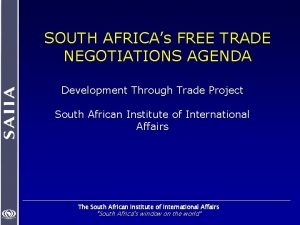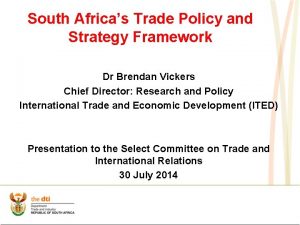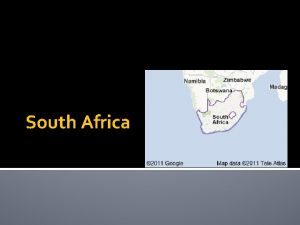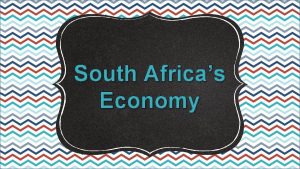Update on South Africas Trade Agreements Presentation to






































- Slides: 38

Update on South Africa’s Trade Agreements Presentation to the Parliamentary Portfolio Committee on Trade and Industry Xolelwa Mlumbi-Peter Deputy Director-General International Trade and Economic Development Division 15 November 2017

Outline of Presentation • International Context • SA policy context and Trade Policy and Strategy Framework • African regional economic integration & the Development Integration Approach • Trade agreements with African countries • Trade agreements with Europe • Update on AGOA • Trade agreements with BRICS countries • World Trade Organisation (WTO) 2

International Context • Backlash against trade liberalisation and globalisation • Main form to date various forms of populism- but growing call for greater inclusivity • Latest IMF economic outlook: 3. 5% globally in 2017; particularly in Europe, India; risks remain on the down-side • US, UK, Middle East: growth forecast revised downwards • Deceleration of growth in China; immediate outlook: stabilization of growth at current level • Africa: slightly improved growth outlook; but barely positive in per capita terms • Increase in protectionism in developed world: while tariffs remain low, countries are increasingly using other types of barriers to restrict trade • Unraveling of regional trade agreements: Brexit and Trans Pacific Partnership (TPP) • 4 th industrial revolution • Importance of regional integration in Africa 3

SA Policy Context • SA Government’s broad national development strategy aims to accelerate growth along a path that generates sustainable development and decent jobs to address apartheid legacies. • Elaborated in the National Development Plan and New Growth Path. • National Industrial Policy Framework (NIPF) and Industrial Policy Action Plan (IPAP) are central components of this strategy and seek to encourage and upgrade value-added, labour-absorbing industrial production. 4

Trade Policy and Strategy Framework • TPSF approved by Cabinet in 2012. • Contributes to Government’s economic development objectives. • Trade policy is an instrument of industrial policy and calls for developmental tariff setting - support industrial development and upgrading, employment growth and increased value-added exports. • Strategic approach to tariff reform. • An evidence-based, case-by-case assessment will inform changes to tariffs (no a priori position) – vital role for ITAC • Implies: – Reduce tariffs on mature upstream input industries lower the costs for downstream, labour creating manufacturing – Raise tariffs on downstream industries with employment or valueaddition potential ensure sustainability and job creation (while observing international trade obligations) 5

Trade Strategy Priorities • Priority is to focus on African development, industrialisation and integration. • Africa needs to shift its current consumption and commodity-driven growth path onto a more sustainable industrial development path. • Pursue “development integration” in SACU, SADC, T-FTA and C-FTA: market integration; industrialisation and regional value-chains; and infrastructure development. • Maintain trade and investment relations with industrialised economies. • Work to build industrial complementarities and shift structure of trade with dynamic economies of the South, e. g. BRICS. • Work to ensure a development-outcome to the WTO’s Doha Round, through the development of a Post-Nairobi Work Programme. 6

Regional Economic Integration in Africa (REI) 7

Approach to REI Development integration • SA advocates a developmental integration approach in all African regional economic integration initiatives. • Informed by the realization that trade integration alone does not bring sufficient economic benefit, and therefore attempts to address industrial capacity and infrastructure development. Market integration - FTAs Industrial development Infrastructure development 8

• SA ENGAGEMENTS WITH AFRICAN COUNTRIES/BLOCS SACU: • • Oldest Customs Union – allows free movement of goods. Review of the Agreement • SADC: • • 13 SADC MS have established a Free Trade Area (FTA) – priority is the consolidation of the FTA rather than establishment of a Customs Union Market of 277 million people. Angola and DRC still to join the Trade Protocol. SADC expanding- Comoros has joined SADC (market of less than 1 million), Burundi is applying to join. Trade in Services Protocol was concluded in 2012. Currently negotiations are underway to liberalize trade in 6 services sectors. All 15 countries in SADC have signed the Services Protocol - negotiations in transport, financial, telecommunications and tourism finalised. Negotiations in energy and construction services still ongoing. Regional Industrial Development strategy approved but still some way from being implementable. 9

Tripartite Free Trade Area (TFTA) • T-FTA will combine markets of 26 countries with a population of nearly 625 million and a combined GDP of US$1. 6 trillion. • Phase I – trade in goods and Phase II - trade in services negotiations, cooperation on IPR, investment, competition policy. • Based on the development integration model. • Key focus is to unlock industrial development through the RVCs and promote intra-regional investments – Role of Trade Invest Africa (TIA) – Encourage SA companies to work with the region to develop RVC in key sectors such as autos and promote complementarities. • The negotiations on the legal framework concluded • Focus is on tariff negotiations. • Modalities for tariff negotiations: 60% immediate liberalization, 25 % over 5 to 8 years and 15 % sensitive but subject to negotiations. 10

TFTA – Market Integration cont. • • EAC : – Tariff book • 36. 7% of the tariff lines are at 0 • 21. 4% at 10% • 40. 8% at over 25% – Offer • 3264 (60%) will be at 0 at entry into force • 1360 (25%) will be liberalized over 5 years • 762 (14%) – subject to negotiations. Egypt – Free Immediately – 3348 (59. 8%) – Phase down over 5 years – 1353 (24. 1%) – Sensitive but subject to negotiations – 871 (15. 5%) PHASE II: TRADE IN SERVICES NEGOTIATIONS, COOPERATION ON IPR, INVESTMENT, COMPETITION POLICY • Negotiations have not commenced. A consultative meeting planned for November 2017 will provide a way forward on these negotiations 11

Continental FTA (CFTA) • • Regional integration and aspirations of Agenda 2063 entrenched in SA national priorities. The CFTA will build on the acqui at RECs and the TFTA to be the building blocs for the CFTA. Based on development integration approach. The modalities for Trade in Goods (Tariff Negotiations) and Trade in Services which are the cornerstone for the negotiations, were adopted by the AU Ministers of Trade during the 3 rd AMOT in June 2017: q The modalities for tariff negotiations include a level of ambition of 90% of tariff liberalisation. The remaining issues (i. e. anti-concentration clause, sensitive product list and exclusions remain to be negotiated) q The technical working group on trade in services have been tasked to determine the priority sectors for liberalisation in a phased approach. • Focus is on negotiations of the Draft CFTA texts (Framework Agreement, Annexes and Appendices) 12

Benefits of TFTA and CFTA for South African Exporters • Legal certainty and predictability of regional market • Encouraging a rules based trade regime • Possibility for fair and impartial dispute resolution mechanism • Broadening regional integration • Development of regional value chains • Facilitation of movement of goods and services in the region • Promotes intra-regional investments 13

Trade Agreements with countries in Europe 14

Economic Partnership Agreement (EPA) between the EU and SADC EPA Group • The EU as a block remains SA’s largest trading partner. • TDCA between SA and EU entered into force on 1 January 2000 and has been fully implemented since 2012 • Total trade between SA and EU increased from R 150 billion in 2000 to R 588 billion in 2016. SA exports to the EU increased from R 64 billion to R 250 billion, while imports from the EU increased from R 86 billion to R 338 billion. • SA decided to join EPA process to establish a regional agreement with the EU and to secure further market access especially in agriculture. • The EPA was signed on 10 June 2016 and provisionally entered into force on 10 October 2016, except for the new agriculture market access negotiated. • New agriculture market access entered into force on 1 November 2016. 15

Improved market access • Two tariff reductions have taken place on SACU and EU side: Ø first reductions occurred on 10 October 2016 for fisheries and on 1 November 2016, for new agricultural market access. Ø second reductions occurred on 1 January 2017 • EPA replaced the trade chapter of TDCA at entry into force. • SA achieved its objectives and improved market access beyond that under the TDCA on fisheries products as well as 32 agricultural products including: Ø New access for sugar (150 000 tons) and ethanol (80 000 tons) Ø Improved duty preference: flowers, some dairy, fruit products, canned fruit Ø Improved quota for wine from 50 mn to 110 mn litres 16

Improvement on TDCA – text provisions • SA also managed to improve text provisions from what was agreed in TDCA as follows: – EPA rules of origin would now allow for extended cumulation that can facilitate intra-regional trade and industrialisation across the Southern and Eastern Africa region in particular – Export taxes can be introduced on exports to the EU under certain circumstances – Standstill clause will not apply to products excluded from liberalization; tariffs on products from EU can be increased provided margin of preference agreed is maintained – Bilateral Safeguard Provision will continue to apply indefinitely on all products subject to liberalization – Automatic Specific Agricultural Safeguard agreed on list of products – Single stage transformation rule of origin on clothing and textiles 17

SA–EU Geographical Indications • The SADC-EU EPA made provision for a bilateral protocol between SA and the EU on the protection of GIs and on trade in wine and spirits. • The Protocol addresses the issue of protection of SA’s wine names exported to the EU and vice versa, as well as protection of a list of agricultural products. • The GI negotiations reached an agreement that will ensure the protection of product names currently being used by producers in the EU and SA: - the EU received protection of names for 251 GIs (120 wines, 5 beers, 20 spirits and 106 agricultural products; the latter includes special meats, cheese, olives, etc. ) - SA received protection for 105 GI names (102 are wine names; and 3 agricultural product names: Rooibos, Honeybush and Karoo Lamb). Provision also made for South Africa to add 30 agricultural product names in future. 18

EPA Benefits for SA • Improved market access for 32 agricultural products, with a significant improvement in our access to the EU market for wine (110 million litres duty free), sugar (150 000 tons duty free) and ethanol (80 000 tons duty free). • Improved access for our exports of flowers, some dairy, fruit and fruit products. • New market access for our fishery products. • The EPA rules of origin improve on the TDCA as they allow for extended cumulation that can facilitate intra-regional trade and industrialisation across the Southern and Eastern Africa in particular. • Several other restrictive trade rules under the TDCA, like on export taxes and standstill clause have been eased under the EPA and new safeguard provision included in EPA. • Protocol on Geographical Indications (GIs) that protects 102 South African wines and three agricultural product names (Rooibos, honey bush and karoo lamb). 19

Effect of BREXIT on EPA • The United Kingdom (UK) is South Africa’s 7 th biggest trading partner and 2 nd biggest trading partner in the EU. • For agricultural exports, the UK was the 3 rd biggest market in the world in 2015 with 30% of all SA’s fruit exports going to the UK and 25% of all wine exports. • In March 2017, the UK Prime Minister gave notice under Article 50 of the Lisbon Treaty that the UK will be leaving the EU. This notification started the two year period of negotiations for the UK exit from the EU. • Currently the UK is still part of the EU and is provisionally applying the EPA as decided by the EU Parliament. • Until the UK completes negotiations and exits the EU, all the obligations of the EU, including under the EPA, will stay in place. • SA’s objectives is to ensure that there will be no interruption in trade between SA and the UK once the UK exits the EU and to engage towards a post-Brexit arrangement that will promote predictability and certainty in trade. 20

Effect of BREXIT on EPA • Agreement in principle is to use the EPA as a basis – pragmatic approach to ensure seamless trade. • There a number of Tariff Rate Quotas (TRQs) in the EPA and SA will have to negotiate the volume of the TRQs with the UK. • Since the TRQs in place with the EU were never increased as more countries became part of the EU, like Croatia in 2014, it is SA’s position that the volume of TRQs in the EPA should not be reduced with the UK exit from EU. • SACU and the UK Trade Ministers met in July 2017 and agreed to start the technical engagements to put in place an interim arrangement based on the EPA that will govern the trade between the UK and SACU as of the day the UK officially exit the EU. • Senior Officials met in October 2017 and had a dialogue on a post. Brexit arrangement. 21

European Free Trade Association (EFTA) FTA • EFTA comprises of Iceland, Liechtenstein, Norway and Switzerland. • The agreement was signed in 2006 and entered into force on the 1 st May 2008. • The trade balance between South Africa and EFTA has consistently been in SA’s favour. • SA’s main exports are primary products. • The Agreement has been due for review since 2013; however, it has been postponed pending the conclusion of the EPA negotiations. Now that the EPA negotiations are concluded, the SACU EFTA review will resume and preparations are underway. • Improvement of SACU’s access to EFTA will only be pursued for basic and processed agricultural products as DFQF treatment is already applied to all non-agricultural products. 22

Africa Growth and Opportunities Act (AGOA) of the United States of America 23

US-SA bilateral trade • As a single country, the US was the 2 nd largest destination for SA exports globally in 2016 (after China). • Bilateral investments between SA and US were approximately R 2 trillion in 2014 • South Africa is home to over 800 US companies and the number is growing rapidly • Similarly, a growing number of SA companies invest in the US • AGOA utilisation rate: – Out of 1835 tariff lines, SA utilised 141 (8% utilisation rate), while sub-Saharan Africa (SSA) utilises 367 (20%) – Out of 3400 GSP lines, SA utilised 459 (14%). SSA utilises 819 tariff lines (17%) – 40% of the products exported are commodities. 24

What is AGOA? • AGOA expands duty-free product coverage under the Generalized System of Preferences (GSP) by an additional 1 835 products - GSP provides duty free Treatment for 3 400 products plus a further 1 450 products from least developed beneficiary countries (LDCs) • AGOA, including GSP, provides duty-free market access for: – 5 235 tariff lines from SSA countries classified as developing countries, and 6 685 tariff lines for least developed countries. • As of 1 July 2016, President Obama announced that 27 travel and luggage goods will receive duty-free treatment under GSP and AGOA. – 11 lines are leather & plastic products; and 16 lines are other textile goods. • AGOA removes the competitive limitation under GSP on exports to USA. Therefore, no ceiling for exports under GSP for AGOA beneficiary countries. • AGOA also offers preferential rules of origin for products from beneficiary-countries. 25

Eligibility Criteria • To qualify for AGOA benefits, a country should meets the AGOA eligibility criteria which aims to ensure continual progress by beneficiary countries towards establishing: – – – market-based economies, the rule of law and political pluralism, elimination of barriers to US trade and investment, protection of intellectual property, efforts to combat corruption, and policies to reduce poverty, among others. • The USTR is required to do annual reviews on the eligibility of SSA countries for AGOA trade preferences. • In addition, the AGOA extension legislation of 2015 introduced out-of -cycle reviews of beneficiaries that provide for withdrawal, suspension or limitation of benefits as sanctions for non-compliance with the eligibility criteria. 26

Eligibility Criteria cont. • The AGOA extension legislation of 2015 prescribes that: – any US stakeholder can request for a country’s eligibility to be reviewed if it deems the country to be in violation of the eligibility criteria (Out-Of. Cycle Review). In the case of South Africa, such a review was started in July 2015, within 30 days of the enactment of the AGOA Extension and Enhancement Act and concluded in March 2016 following successful resolution of the issues of concern to the US, viz. the 3 meats issues. – the USTR submit a report to US Congress on “Policy Levers for Deepening and Broadening Trade and Investment Relationship between Africa and the United States” ---- one year after enactment of the Act, every 5 years. The USTR is required to submit to Congress a report that identifies sub-Saharan African countries that have expressed an interest for and / or that are deemed to have the capacity for entering into a comprehensive free trade agreement with the United States. • The new Act further requires the AGOA beneficiary countries to draft AGOA utilization strategies 27

AGOA Product Coverage • Eligible product list covers all sectors with the exclusion of the following textiles and textiles articles: – Man-made staple fibers; – Special woven fabrics; tufted textile fabrics; lace, tapestries; trimmings; embroidery) – Knitted or crocheted fabrics • Other products also excluded from AGOA and GSP include: – Agro processing sector (i. e. chemically pure sucrose sugar; canned peaches and peach juices) – silicon; and – electrolytic manganese metal powder. 28

Take aways from the 16 th AGOA Forum • • Africa needs partners that will support its regional integration and industrial development efforts - relations will be guided by these principles AGOA is a temporary trade arrangement and will be in force for eligible countries until 2025. Countries are urged to enhance their utilisation for the remaining 7 years and establish their presence in the US market. Access to AGOA benefits remain risky as the US will continue to use annual and out-of--cycle eligibility reviews as tools to help US companies to gain more privileged access to trade, investment and project opportunities in African markets. US will focus on enforcement and will leverage the eligibility criteria to reduce trade deficit and pursue “fair trade”. Need to sharpen our message – emphasise mutual benefits through our trade to the US, intra-industry linkage and jobs for both sides. AGOA has been beneficial to both the US and SA and has facilitated improved and more balanced trade, particularly in value added products. The US encourages SSA countries to start thinking about its trade relationship with the US beyond AGOA but no clear policy towards Africa from the current administration. 29

Trade Agreements with BRICS countries 30

SACU-India Preferential Trade Agreement (PTA) • • PTA can boost south-south trade in a targeted manner. More focused approach to tariff preferences compared to FTA. Also provides legal-institutional framework to manage trade. India is now SA 5 th largest trade partner with trade in 2015 with over R 95 billion. • Difficulty in finalising SA/SACU offer - Concerns raised with negotiations include NTBs in the Indian market and requests by India in sensitive sectors like textiles and clothing. • Looking at reduced level of tariff exchange coverage and use the PTA as an incremental building block to enhanced trade in future. 31

SACU – MERCOSUR Preferential Trade Agreement (PTA) • MERCOSUR comprises of Argentina, Brazil, Paraguay and Uruguay. Venezuela recently became a member of MERCOSUR but has been suspended since December 2016. • The PTA is aimed at promoting trade between the two sides on on over 1000 tariff lines on both sides. • The PTA was concluded and signed in 2008. • PTA creates a legal basis for further integration and cooperation including through possible further exchanges of tariff preferences, as well as cooperation in a range of other areas. • Offers preferential margins of between 10% and a 100%. • The PTA entered into force on 1 April 2016. South Africa implemented the agreement on 10 October 2016 retrospectively to 1 April 2016. • The First Joint SACU-MERCOSUR Committee meeting under the PTA took place on 23 -24 May 2017 in South Africa. 32

World Trade Organisation (WTO) 33

WTO • The 11 th Ministerial Conference (MC 11) to be held in December 2017 in Argentina. • Period of considerable uncertainty in trade policy, including a widening backlash against trade agreements and globalization. • Trump Administration low level of engagement. • Divergences on the mandate of the development agenda in the DDA. • Strong push for “cherry-picking” - strong push for launching of negotiations on e-commerce rules at MC 11 • On e-commerce South Africa, and Africa, have advance a position that it is premature to consider negotiations of trade rules on e-commerce. • While it is clear that e-commerce is developing rapidly across the globe, that development is highly uneven and e-commerce is extremely concentrated amongst a few countries. This underscores the persistence and depth of the digital divide that relates to infrastructure, finance, technology, industry, skills and income. 34

Africa Position • Principles • Ø developmental objectives and principles of the DDA, including special and differential treatment and less than full reciprocity remain key; Ø development package must remain at the core of any negotiating outcome; Ø prioritize and conclude all unresolved issues in the DDA. Agriculture Ø Eliminate trade distorting domestic support that constrain Africa’s full potential in agricultural production and trade. Ø Permanent Solution for Public Stockholding which should include new programs. Ø Special Safeguard Mechanism to respond to volatility in global agricultural commodity markets • Cotton Ø Eliminate all trade distorting policies affecting the sector and fast track the resolution expeditiously by MC 11. 35

Africa Position • Fisheries subsidies • Ø Calls for a multilateral agreement to discipline certain forms of subsidies that contribute to overfishing and overcapacity as agreed in goal 14. 6 of the 2030 Agenda Special and Differential Treatment (S&D) Ø S&D shall be an integral part of all WTO agreements and future multilateral outcomes and shall be embodied, in the schedules and in the rules and disciplines, so as to enable developing countries to address their development needs in line with Africa’s industrial development priorities and Agenda 2063; • Services Ø Reaffirm the flexibilities for developing countries as inscribed in the GATS, Annex C of the Hong Kong Ministerial Declaration and the LDC Modalities. Ø any outcome on GATS Article VI. 4 disciplines on domestic regulation does not involve implementation of new and/or onerous administrative requirements or requirements that intrude into the domestic-policy making processes 36

Africa Position • LDCs Ø priority attention to be accorded to LDC issues, including showing maximum flexibility to African LDCs undergoing accession. • Trade-Related Aspects of Intellectual Property Rights (TRIPS) Ø amend the TRIPs Agreement to ease access to affordable medicines, introduce requirements for disclosure, prior informed consent and benefit sharing in respect of traditional knowledge so that the TRIPS Agreement and the Convention of Biological Diversity are mutually reinforcing. • Trade Facilitation Agreement (TFA) Ø call for the expansion of its scope to include both soft and hard infrastructure projects to facilitate full implementation of the Agreement. • Aid for trade Ø underline the importance of Aid for Trade initiatives in trade-related capacity-building, overcoming supply-side constraints, infrastructure development, and facilitating integration of developing economies, in particular LDCs in regional and global trade. 37

WTO cont. • SA Position: – Preserve the multilateral trading system but that supports development more decisively – Continue to advocate for progress on the outstanding Doha issues. – Any package agreed must have clear developmental character and content and should ensure trade supports inclusive growth. – Focus in e-commerce should be on cooperation, addressing the digital divide and exploring options for promoting digital industrial policy. The most we could agree to is a roll-over of the current ecommerce Work Programme and temporary moratorium on customs duties on electronic transmissions. – We will need to calibrate expectations realistically - the best outcome for MC 11, in the current context, may be simply to preserve the status quo in the WTO. 38
 Whats africas largest lake
Whats africas largest lake Alternative of log based recovery
Alternative of log based recovery Old south vs new south streetcar named desire
Old south vs new south streetcar named desire Trade diversion and trade creation
Trade diversion and trade creation Umich
Umich Trade diversion and trade creation
Trade diversion and trade creation The trade in the trade-to-gdp ratio
The trade in the trade-to-gdp ratio Fair trade not free trade
Fair trade not free trade Trade diversion and trade creation
Trade diversion and trade creation Types of tramp chartering
Types of tramp chartering Triangle trade map
Triangle trade map Enlarging the pie
Enlarging the pie Yalta conference agreements
Yalta conference agreements Unanimous agreements
Unanimous agreements International hardwood agreements
International hardwood agreements Vendor rebate system
Vendor rebate system What is uncertain agreement
What is uncertain agreement The four agreements preview
The four agreements preview Mpi salary bands
Mpi salary bands Long term service agreements
Long term service agreements Bcgeu collective agreements
Bcgeu collective agreements Bc labour relations board
Bc labour relations board Genuine agreement
Genuine agreement Boston associates apush
Boston associates apush Yalta conference agreements
Yalta conference agreements Master clinical trial agreements
Master clinical trial agreements Horizontal agreements examples
Horizontal agreements examples Forward freight agreement definition
Forward freight agreement definition International framework agreements
International framework agreements Forward rate agreements
Forward rate agreements Drafting license agreements
Drafting license agreements Supplier rebate agreements
Supplier rebate agreements Fetal lie
Fetal lie Vertex presentation and cephalic presentation
Vertex presentation and cephalic presentation Zechariah stevenson
Zechariah stevenson Zechariah stevenson update
Zechariah stevenson update University community plan
University community plan Temporary update problem in dbms
Temporary update problem in dbms Www sabupdate
Www sabupdate














